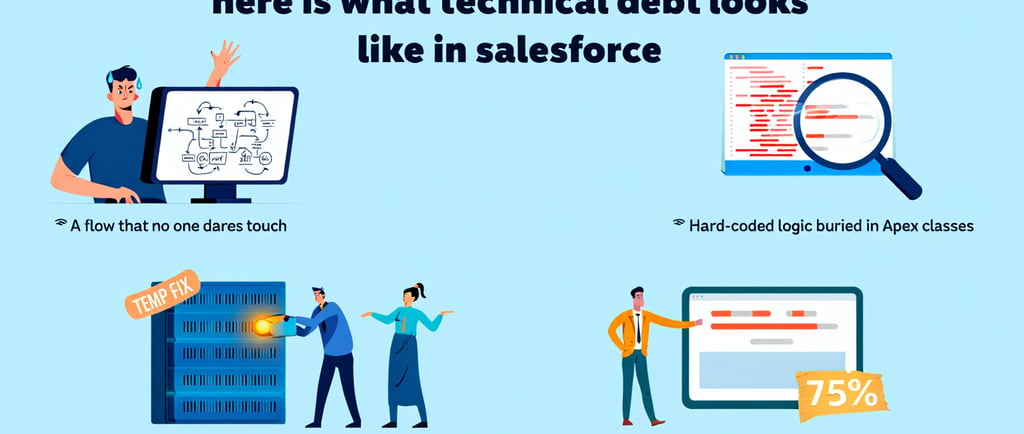Introducing the D.E.B.T. Framework for Scalable Systems
If your Salesforce org is getting harder to manage, slower to change, and full of don’t-touch-that zones... You’re likely drowning in technical debt. And no it’s not just a developer problem. It’s a business scalability problem hiding in plain sight.
SALESFORCEAPEX PROGRAMMINGSALESFORCE OPTIMIZATION
6/12/20251 min read


What Is Technical Debt?
Technical debt is the cost of shortcuts.
The quick fixes, manual workarounds, and aging configurations that pile up over time.
On the surface, they help you move fast.
But in reality?
They slow your team down, frustrate users, and kill innovation.
You can’t scale on top of a fragile foundation.
The D.E.B.T. Framework: A Practical System for Managing Tech Debt
You don’t need a massive overhaul.
Just a consistent system to chip away at the friction.
Here’s how to do it:
D → Diagnose
Start by making the invisible visible.
Scan your org for red flags: overly complex flows, hard-coded Apex logic, duplicate fields.
Use tools like PMD, CodeScan, and Salesforce Health Check.
Ask your team: “Which part of this system do you dread working on?”
Every time your devs flinch, that’s a signal.
E → Evaluate Impact
Not all debt is equal.
Score each issue across 3 lenses:
Business Risk: Does this break critical workflows?
Developer Friction: How painful is it to work with?
Frequency of Change: How often do we touch this?
This helps you focus on what hurts most not just what’s visible.
B → Budget Time
Fixing debt doesn’t require a big rewrite.
But it does require intention.
Allocate 10–20% of every sprint for cleanup or refactoring.
Bundle tech debt fixes with feature work when possible.
Use feature flags to avoid “big bang” changes.
Technical debt is like credit card interest if you are not paying it off, it’s growing.
T → Track + Talk
If you don’t track it, you won’t fix it.
Add tech debt items to your backlog as proper tickets.
Label and prioritize them just like you do bugs or features.
Celebrate tech wins: We reduced deployment time by 40% after X refactor.
Make improvement part of the culture.
Build Systems That Scale
The goal isn’t perfection.
It’s progress.
The D.E.B.T. Framework isn’t just about writing cleaner code it’s about creating scalable, maintainable systems that don’t collapse under pressure.